Aloe Vera farming is an attractive and profitable business opportunity that has gained popularity recently due to the growing demand for Aloe Vera products. Aloe Vera is a succulent plant widely known for its medicinal properties and health benefits. This comprehensive business plan guide aims to provide a step-by-step approach for starting an Aloe Vera farming business, from understanding the benefits of Aloe Vera farming to conducting market research, creating a business plan, and calculating profits.
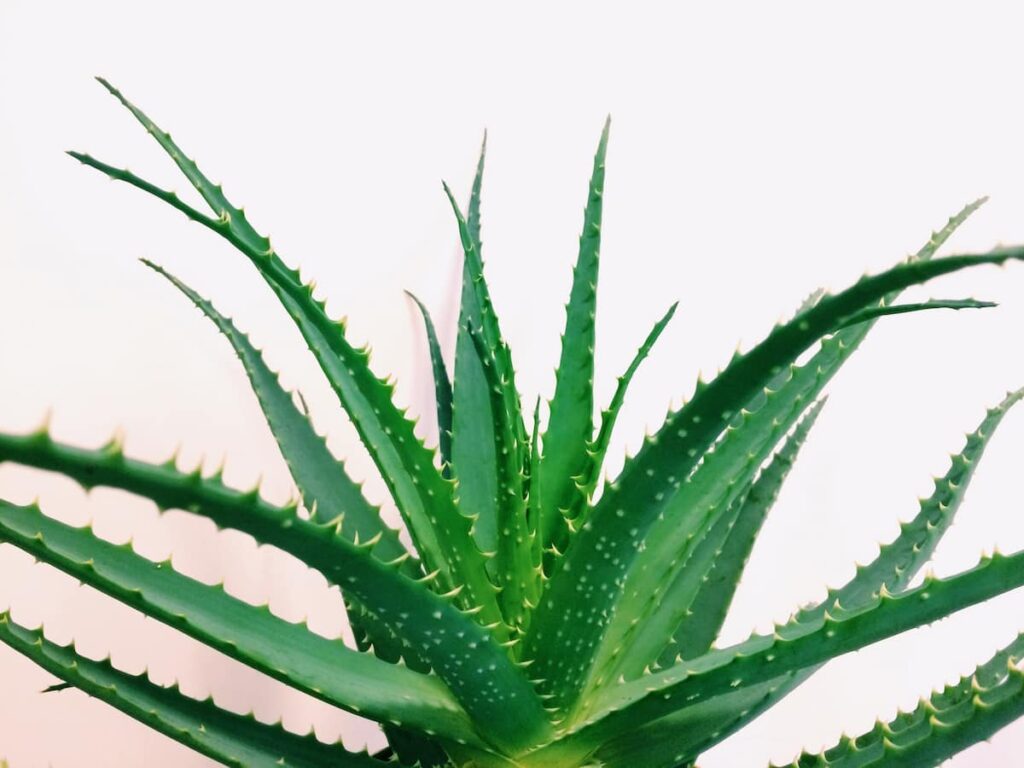
The guide also includes practical tips for successful Aloe Vera cultivation and production, as well as a project report and cost and profit report to help new farmers understand the economics of Aloe Vera farming.
Aloe Vera Farming Business Plan
Introduction to Aloe Vera Farming
Aloe Vera farming is becoming increasingly popular worldwide due to its high profitability, benefits, and low maintenance requirements. Aloe Vera plants can be grown using much less water and effort than traditional agriculture, making it a more sustainable option. Aloe Vera can be sold as plant leaves, or the juice can be extracted and marketed.
Aloe Vera, commonly known as Ghrit Kumari, is an Asphodelaceae or Liliaceae succulent. It is mainly grown in dry areas and is a xerophytic plant. Commercial cultivation is carried out mainly in tropical or subtropical regions like Aruba, Haiti, India, Venezuela, the USA, and South Africa. In India, it is grown in Andhra Pradesh, Gujarat, Maharashtra, Rajasthan, and Tamil Nadu.
Description Of Aloe Vera Plant
- The inner clear gel layer comprises 99% water, amino acids, lipids, sterols, vitamins, and glucomannans.
- The middle layer contains bitter yellow sap with anthraquinones and glycosides.
- Aloe vera is a stemless plant with thick, fleshy leaves that are serrated and green to grey-green.
- A thick outer layer of 15-20 cells called a rind protects the inner gel. The gel also contains high amounts of mucilage, polysaccharides with uronic acids, fructose, and other sugars, and phenolic components with antioxidant properties.
- The rind synthesizes carbohydrates and proteins and contains vascular bundles for transporting substances like water and starch.
Aloe Vera Uses
- Aloe vera gel’s soothing characteristics make it popular in skincare products.
- Aloe vera juice boosts smoothies and nutritious drinks.
- Aloe vera naturally softens and shines hair.
- Aloe vera soothes sunburns, wounds, and other minor skin irritations.
In case you missed it: Aloe Vera Cultivation Information Guide
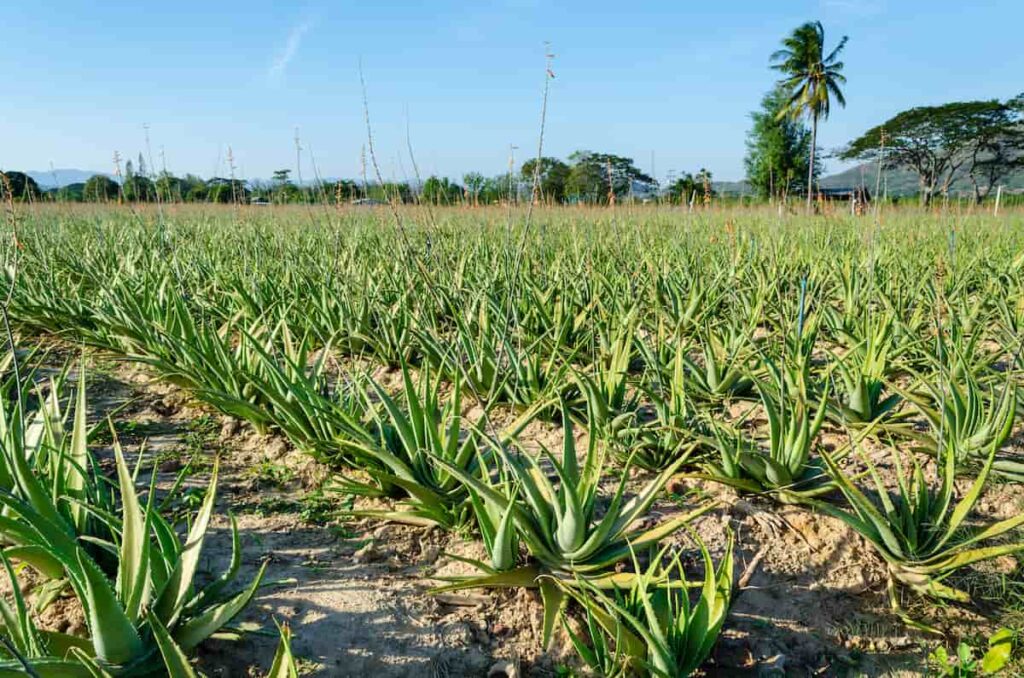
Aloe Vera Health Benefits
- Antioxidants in aloe vera fight free radicals, which harm cells and cause chronic diseases.
- Laxative aloe vera may assist digestion and constipation.
- People with diabetes get many benefits from aloe vera.
- Aloe vera may alleviate inflammation.
Aloe Vera Nutrition Value
- Vitamins A, C, and E in aloe vera keep skin healthy.
- Calcium, magnesium, and potassium in aloe vera strengthen bones and teeth.
- Aloe vera contains amino acids, which help create and repair tissues.
Benefits of Aloe Vera Farming
Commercial aloe vera farming has many advantages, including ease of cultivation, an established market demand, and profitability. As a long-standing business, it provides a stable source of income and requires relatively little capital to start. Aloe vera plants grow rapidly with little care, and their several health benefits make them a sought-after crop. With the availability of many companies to purchase products, marketing aloe vera is easy.
In case you missed it: The Ultimate Guide to Crafting a Profitable Cardamom Farming Business Plan and Maximizing Production
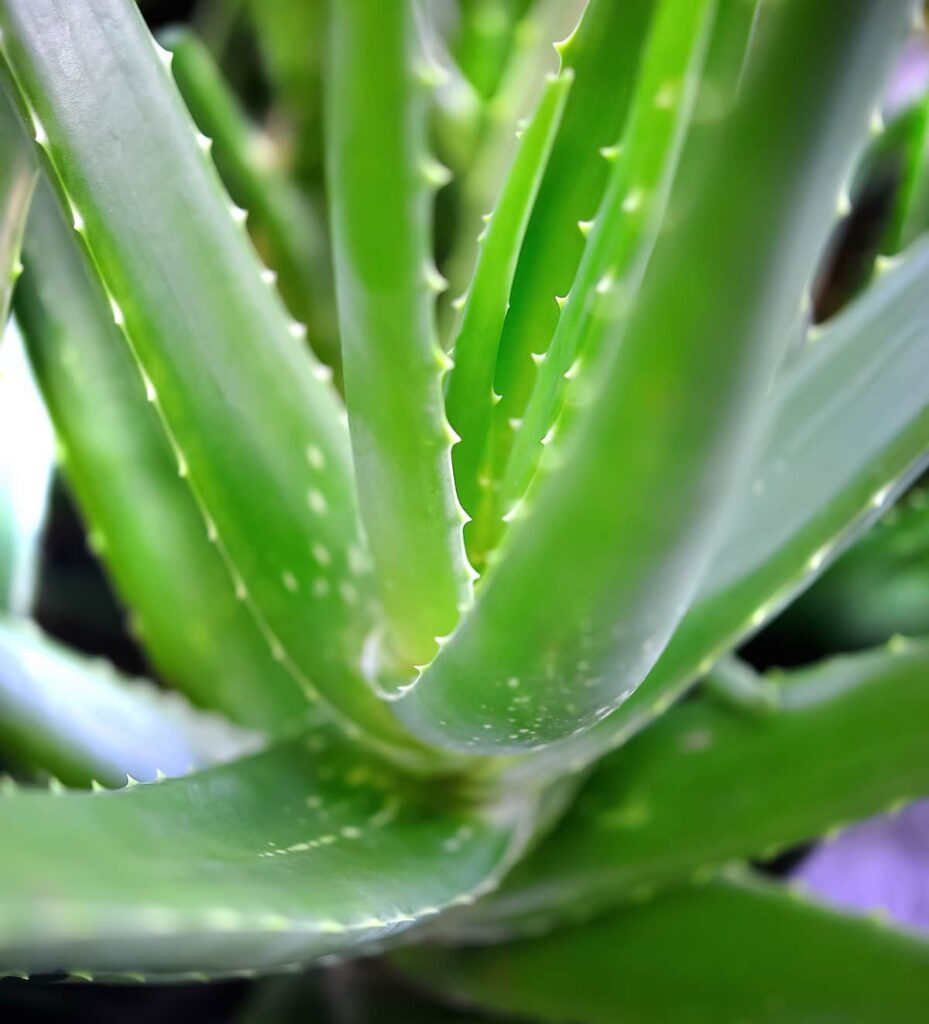
Popular Aloe Vera Varieties
- Aloe Barbadensis Miller: This is the most common and popular variety of Aloe Vera worldwide, known for its medicinal properties.
- Aloe Aristata: Also known as Lace Aloe, it is a smaller variety of Aloe Vera with thin leaves.
- Aloe Vera chinensis: Found in China, it has a sweet taste and is used for various medicinal purposes.
- Aloe Vera Striata: Known for its beautiful green leaves with pink margins, it is a rare variety of Aloe Vera.
- Aloe Vera Juvenna: A small and attractive type of Aloe Vera with white spots on its leaves, it is commonly used for ornamental purposes.
- Aloe Vera Ferox: This variety is native to South Africa and is known for its thick and spiky leaves with bright red flowers.
How to Commercially Grow Aloe Vera and Production
Commercial aloe vera farming is a simple and hardy business that requires minimal care and management. Beginners can learn from experienced farmers, or tips give clear ideas. Starting with planting, the process involves caring for the plants and harvesting the aloe vera. Marketing the product is the final step.
Ideal Conditions and Tips for Aloe Vera Cultivation
Soil and climate requirements: Aloe Vera is a hardy plant that can grow under constant drought conditions. However, it thrives best in tropical and sub-tropical regions with an average rainfall of 35-40 cm annually. Aloe Vera can grow in arid and semi-arid areas with low water availability. For Aloe Vera cultivation, marginal to sub-marginal soils having low fertility can be used.
Proper land preparation is essential for Aloe Vera cultivation. The soil should not be disturbed more than 20-30 cm because the plant’s root system does not penetrate below this level. Farmyard manure should be applied at 10-15 tonnes per hectare at the final plowing stage.
In case you missed it: The Ultimate Guide to Onion Farming Business Plan for Maximum Profit
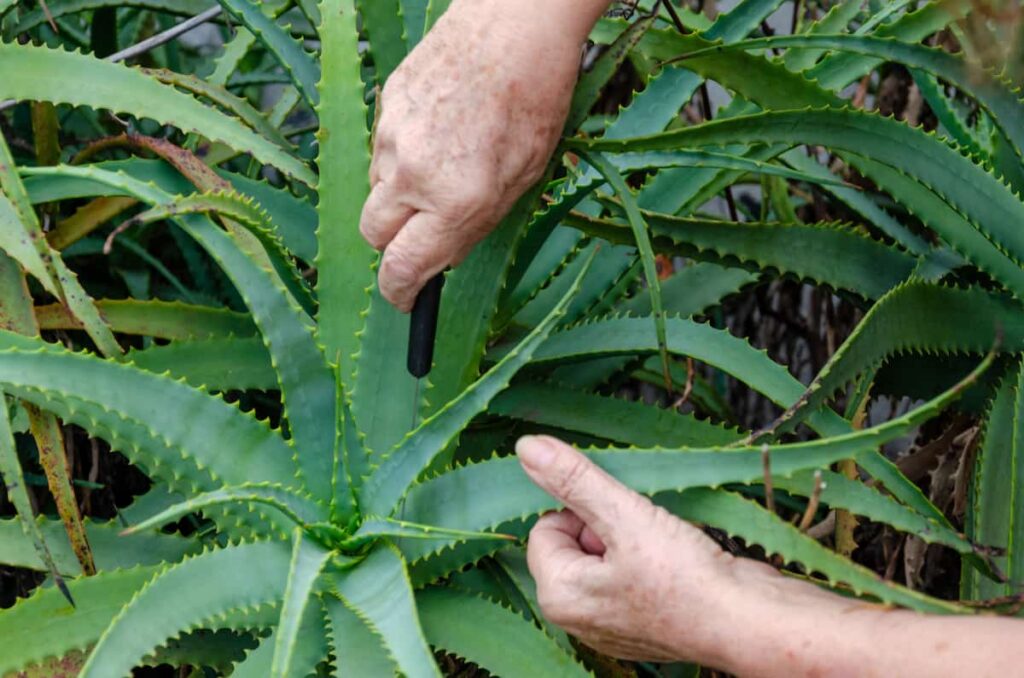
Propagation can be done through root suckers or rhizome cuttings. In the case of rhizome cuttings, the cutting should be 5 to 5.5 cm long with a minimum of two to three nodes. Root suckers should be planted in a row with two-thirds of the plant inside the ground. A spacing of 50×45 cm between plant to plant is recommended.
Irrigation in Aloe Vera farming should be applied every 15 days during dry conditions. Overwatering should be avoided as it can create waterlogging in the field, further destroying crops. The area should be dried before any water application. Organic manures such as farm yard, vermicompost, or green manure are recommended for crop nutrition.
Weeding should be done within a month after planting and twice a year in subsequent years. Aloe Vera fields should be free from weeds throughout the growing period of the crop.
Intercropping with less competitive leguminous plants can improve soil health and generate additional income. However, leguminous crops should not be planted from the second year onward to avoid low-quality produce.
Pest and disease control: Mealybugs, anthracnose, and leaf spots are the main pests and diseases of the Aloe Vera crop. Mealybugs can be treated with Methyl parathion@10 ml or Quinalphos@20 ml in 10 liters of water on the roots and shoots of the plant. Anthracnose can be cured by spraying 70% Neem oil. Black, brown leaf spots can be treated by removing the infected leaves.
Harvesting Techniques and post-harvesting operations in Aloe Vera:
It takes 2-5 years for the plant to yield bountifully, and the leaves can be harvested manually 3-4 times yearly. The average production from a hectare of non-irrigated crop is 15-20 tons, while an irrigated crop can yield up to 30-35 tons. A processing plant can be set up to extract aloe juice or gel. One ton of aloe vera can generate good income by processing it into aloe vera juice, which can be sold to the cosmetic and pharma industries. With a limited budget and small manpower, one can start their aloe vera processing business and earn a profit in crores.
Yield: One hectare of land can produce an average of 40 to 45 tonnes thick leaves.
Project Report on Aloe Vera Cultivation
Aloe Vera farming is becoming profitable, and a well-planned project report is crucial for success. This report should cover the cost of production, potential yield, market demand, and profits. It should also analyze the soil, climate, and water requirements for optimal growth, as well as the risks and challenges involved in cultivation, including pests and diseases.
In case you missed it: Maximizing Profit with a Comprehensive Garlic Farming Business Plan
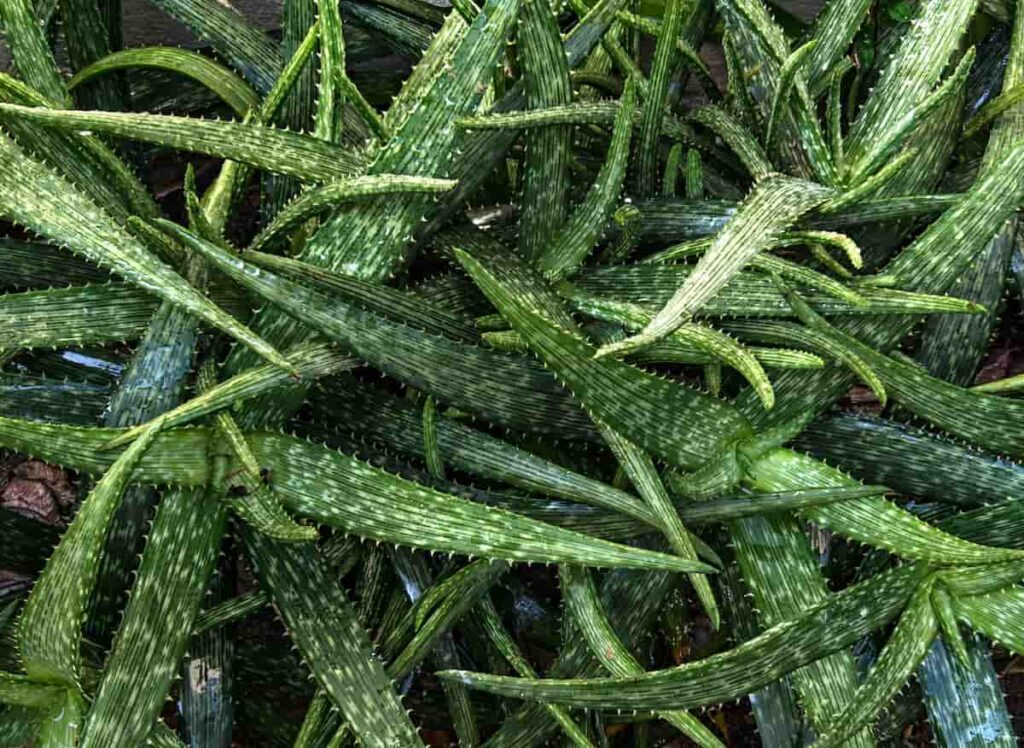
Processing Aloe Vera into different products like juice, gel, and powder is an essential aspect of the business, and the project report should provide detailed information on it. Understanding the market demand for Aloe Vera products.
Cost and Profit Report of Aloe Vera Cultivation
Aloe Vera cultivation has become a profitable business venture with its high demand in the market. The cost of production for 1 acre of land in India is around INR 1.8-2 lakhs ($2,400-$2,700). This cost includes land preparation, planting material, labor, fertilizer, pesticides, and water. With minimal investment, a farmer can plant up to 60,000 plants of Aloe Vera in just one acre of land. From each plant, around 3.5 kg of leaves can be obtained, and the average selling price of Aloe Vera leaves is around INR 15-18 ($0.20-$0.24) per leaf.
A farmer can easily earn a profit of up to INR 8-10 lakhs ($10,800-$13,500) per acre of land. This means that the profit earned is almost five times the cost of production, making Aloe Vera farming an attractive and profitable business venture. It is important to note that the profit margin can vary depending on market demand, pricing, and weather conditions.
Market Research and Analysis of Aloe Vera Farming
- The global Aloe Vera market valued at $602.1 million in 2020-2021 is expected to reach $1.13 billion by 2028, growing at a CAGR of 8.0% from 2021 to 2028.
- The major producing countries of Aloe Vera include India, Mexico, the Dominican Republic, China, and South Africa.
- India is the largest production and exporter of Aloe Vera, accounting for 60% of the world’s production.
- The United States, Germany, and Japan are the major importers of Aloe Vera products.
- The demand for Aloe Vera products is increasing due to their numerous health benefits and applications in the cosmetic and pharmaceutical industries.
- Aloe Vera produces various products, including gels, powders, juices, and extracts.
- The increasing popularity of naturally and organic products is expected to drive the demand for Aloe Vera products.
Aloe Vera Farming Business Plan
An Aloe Vera farming business can be established with minimal investment, as 60,000 plants can be planted on just one acre. The cost of production is approximately $2,500-$3,000 per acre, with a potential yield of 210,000 kg of Aloe Vera leaves per acre per year. The market demand for Aloe Vera products, such as juice, gel, and powder, is high domestically and internationally.
Partnerships can be established with local health stores, markets, and e-commerce platforms to reach a broader customer base. Expected returns are approximately $10,000-$14,500 per acre per year, with an avg selling price of $2.5-$3 per kg of Aloe Vera leaves. Implementing cost-saving strategies, such as organic farming techniques, natural pest control methods, and water recycling, can minimize costs.
However, there are potential risks related to pest and disease management, fluctuations in market prices, and weather conditions. Fortunately, several government schemes are available for financial assistance, including loans and subsidies for Aloe Vera farming. To ensure future growth, continuous investment in research and development is necessary to improve the quality and yield of Aloe Vera plants and products and expand into new markets.
In case you missed it: Rosemary Farming Business Plan: A Step-by-Step Guide to Growing and Selling Profitable Herbs

Business Plan Components of Aloe Vera Farming
Executive summary: Aloe Vera farming is a lucrative business that involves cultivating Aloe Vera plants and processing them into products such as juice, gel, and powder. With high domestic and international demand, Aloe Vera farming has the potential for increased profits. This business plan outlines the essential components of starting and managing an Aloe Vera farming business.
Market analysis: The market demand for Aloe Vera products is high due to the numerous health benefits associated with its consumption. The need for Aloe Vera will continue growing as consumers become more health-conscious. The global market for Aloe Vera products is expected to reach $2.3 billion by 2025.
Cost analysis: Minimal investment is required to start an Aloe Vera farming business. The cost of production for one acre of land is approximately $2,500-$3,000 (Rs 1.8-2 lakhs), with a potential yield of about 210,000 kg of Aloe Vera leaves per acre per year.
Marketing strategies: To reach a target potential customer base, establish partnerships with local health stores, markets, and e-commerce platforms. Utilize social media platforms to promote the products and engage with potential customers.
Risk management: To mitigate risks, implement organic farming techniques, use natural pest control methods, and recycle water to minimize costs. Monitor weather conditions and market prices to ensure profitability.
Government support: Several government schemes are available for financial assistance, including loans and subsidies for Aloe Vera farming.
Conclusion
Aloe Vera farming can be profitable with minimal investment and high returns. By implementing cost-saving strategies, establishing partnerships, and continuously investing in research and development, farmers can maximize their profits and grow their businesses.
- Crops Grown in Summer Season: Best Choices for Summer Gardening
- Organic Pest Control for Tomato Farming
- How to Maximize Sheep Farming Profit
- Broccoli Varieties: Choosing the Right Cultivars for Your Farm
- How to Raise Pigs in Your Own Backyard: A Comprehensive Guide
- Budget Friendly Sheep Shed Ideas: Cheap and Low-Cost Tips
- How Much Do Cattle Farmers Make: Revenue Streams in Cattle Farming
- Management Pests and Diseases in Your Cotton Field
- Sheep Farming Business Plan for Beginners
- Aquaponic Farming at Home: A Step-By-Step Guide
- Profitable Village Farming Business Ideas in 2024
- High-Yield Aquaculture: Fast-Growing Fish for Farming
- Effective Fish Pond Construction Techniques for Beginners
- Irrigation and Water Management in Pineapple Farming
- Blossom to Harvest: Mastering Flowering and Pollination in Papaya Farming
- Pig Fattening Essentials: From Selection to Sale for Beginners
- Raising Wagyu Cattle: A Complete Guide for Premium Beef Production
- Soil Types and Their Water Holding Capacity
- Optimizing Irrigation Schedules for Coconut Groves for Enhanced Yield
- Espresso Your Garden: Coffee Grounds for Healthier Acid-Loving Plants
- The Best Soil Mix for Snake Plants: How to Mix Your Own Snake Plant Soil
- Green Thumb Success: Expert Tips for Cultivating Greenhouse Beans All Year Round
- Bloom All Year Round: The Ultimate Guide to Indoor Hyacinth Care
- Eco-Friendly Gardening: How to Make Liquid Fertilizer from Kitchen Waste
- Ultimate Guide to Grow Anise in Pots: Explore Seed Propagation to Harvesting
- Guide to Raising Chester White Pigs: Discover Breed Facts to Growth Management
- Mastering the Elegance: The Ultimate Guide to Weeping Cherry Tree Care, Planting, and Maintenance
- Ultimate Guide to Planting Garlic in Grow Bags: Growing Strategies for Beginners
- How to Fix Spider Plant Leaf-Related Problems: Natural and Organic Remedies
- 10 Reasons Why Your Tulsi Plant is Shedding Leaves: Home Remedies and Solutions
- Optimizing Growth and Yield: The Advantages of Palm Bunch Ash Fertilizer
- Utilizing Neem Oil Extract as a Natural Pesticide for Hydrangea
- From Soil to Harvest: Various Ways in Which Farmers Can Use AI Tools
- Steps to Encourage and Induce Citrus Flowers: A Comprehensive Guide
- How to Fix Snake Plant Leaf-Related Issues: Natural and Organic Remedies
- Transform Your Garden into a Fragrant Oasis with Raat Ki Rani (Night Blooming Jasmine)

Super